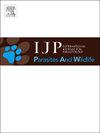蜱虫媒介(节肢动物目:蜱虫科:蜱虫科)和非洲豹(Panthera pardus pardus)的生活史阶段
IF 2.2
3区 医学
Q3 ECOLOGY
International Journal for Parasitology-Parasites and Wildlife
Pub Date : 2025-02-20
DOI:10.1016/j.ijppaw.2025.101049
引用次数: 0
摘要
来自Hepatozoon Miller 1908属的细胞内顶复合体血寄生虫已在广泛的脊椎动物宿主中被描述,包括非洲的野生食肉动物。关于非洲豹Panthera pardus pardus (Linnaeus 1758)的报道很少,而且通常不具有特异性,对感染媒介的传播方式和生命周期阶段的描述仍然相对较少。本研究的目的是探讨蜱作为感染南非非洲豹的一种肝虫的潜在媒介的作用。在镇静状态下采集了5只野生豹子(3只雌性和2只雄性)的外周血和充血蜱。姬姆萨染色涂片的外周血筛选肝zoon淋巴细胞分期,包括白细胞外和白细胞内。随后,从受感染的豹子身上吸饱的蜱虫在禁食状态下存活7天,然后解剖并涂抹在干净的显微镜载玻片上,用吉姆萨溶液染色,并筛选各种可能的发育阶段。从感染荷兰Van As和Smit 2020年肝虫的雄性豹身上采集的蜱(Ixodes sp.)中观察到孢子发育阶段,包括小配子、未成熟卵囊和成熟卵囊以及感染性孢子子。用ImageJ软件对发育阶段进行拍照、区分和测量。刮取一张涂片显微镜载玻片,用于遗传鉴定这种血红素的身份。本文首次报道了一种猫科动物肝虫在其潜在蜱虫媒介和非洲豹宿主中不同发育阶段的特征。本文章由计算机程序翻译,如有差异,请以英文原文为准。

Life cycle stages of Hepatozoon ingwe (Apicomplexa: Adeleorina: Hepatozoidae) in an Ixodes sp. tick vector (Arthropoda: Ixodida: Ixodidae) and an African leopard Panthera pardus pardus
Intracellular apicomplexan haemoparasites from the genus Hepatozoon Miller 1908 have been described from a wide range of vertebrate hosts, including wild carnivores in Africa. Reports from the African leopard, Panthera pardus pardus (Linnaeus 1758) are scarce and generally non-specific, and description on the mode of transmission and life cycle stages in infected vectors remains relatively rare. The aim of this study was to explore the role of ticks as potential vectors of a species of Hepatozoon infecting African leopards in South Africa. Peripheral blood samples and engorged ticks were collected from five wild leopards (three females and two males) while under sedation. Giemsa stained smears of peripheral blood were screened for Hepatozoon gamont stages, both extra- and intraleukocytic. Engorged ticks from infected leopards were subsequently kept alive in a fasting state for seven days before being dissected and smeared on clean microscope slides, stained with Giemsa solution, and screened for various possible developmental stages. Sporogonic stages, including microgametes, immature and mature oocysts and infective sporozoites, were observed in a tick (Ixodes sp.) collected from a male leopard infected with gamont stages of Hepatozoon ingwe Van As, Netherlands and Smit 2020. Developmental stages were photographed, differentiated and measured with ImageJ software. One tick-smear microscope slide was scraped and used for genetic confirmation of the identity of this haemogregarine. This is the first report on the characteristics of different developmental stages of a feline species of Hepatozoon in both its potential tick vector and African leopard host.
求助全文
通过发布文献求助,成功后即可免费获取论文全文。
去求助
来源期刊

International Journal for Parasitology-Parasites and Wildlife
Medicine-Infectious Diseases
CiteScore
3.80
自引率
5.60%
发文量
113
审稿时长
45 days
期刊介绍:
The International Journal for Parasitology: Parasites and Wildlife (IJP-PAW) publishes the results of original research on parasites of all wildlife, invertebrate and vertebrate. This includes free-ranging, wild populations, as well as captive wildlife, semi-domesticated species (e.g. reindeer) and farmed populations of recently domesticated or wild-captured species (e.g. cultured fishes). Articles on all aspects of wildlife parasitology are welcomed including taxonomy, biodiversity and distribution, ecology and epidemiology, population biology and host-parasite relationships. The impact of parasites on the health and conservation of wildlife is seen as an important area covered by the journal especially the potential role of environmental factors, for example climate. Also important to the journal is ''one health'' and the nature of interactions between wildlife, people and domestic animals, including disease emergence and zoonoses.
 求助内容:
求助内容: 应助结果提醒方式:
应助结果提醒方式:


